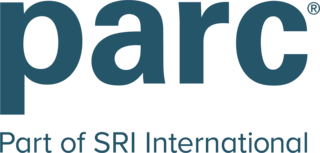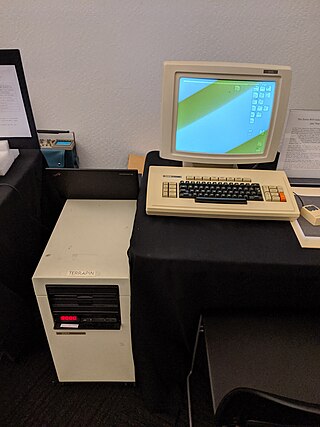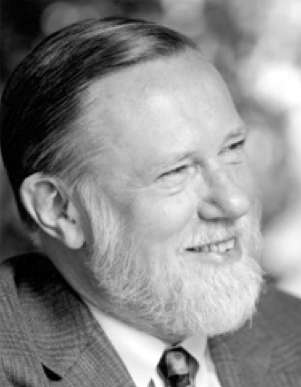
PARC is a research and development company in Palo Alto, California. It was founded in 1969 by Jacob E. "Jack" Goldman, chief scientist of Xerox Corporation, as a division of Xerox, tasked with creating computer technology-related products and hardware systems.

Xerox Holdings Corporation is an American corporation that sells print and digital document products and services in more than 160 countries. Xerox is headquartered in Norwalk, Connecticut, though it is incorporated in New York with its largest population of employees based around Rochester, New York, the area in which the company was founded. The company purchased Affiliated Computer Services for $6.4 billion in early 2010. As a large developed company, it is consistently placed in the list of Fortune 500 companies.

3Com Corporation was an American digital electronics manufacturer best known for its computer network products. The company was co-founded in 1979 by Robert Metcalfe, Howard Charney and others. Bill Krause joined as President in 1981. Metcalfe explained the name 3Com was a contraction of "Computer Communication Compatibility", with its focus on Ethernet technology that he had co-invented, which enabled the networking of computers.

Laser printing is an electrostatic digital printing process. It produces high-quality text and graphics by repeatedly passing a laser beam back and forth over a negatively charged cylinder called a "drum" to define a differentially charged image. The drum then selectively collects electrically charged powdered ink (toner), and transfers the image to paper, which is then heated to permanently fuse the text, imagery, or both, to the paper. As with digital photocopiers, laser printers employ a xerographic printing process. Laser printing differs from traditional xerography as implemented in analog photocopiers in that in the latter, the image is formed by reflecting light off an existing document onto the exposed drum.

Butler W. Lampson, ForMemRS, is an American computer scientist best known for his contributions to the development and implementation of distributed personal computing.

The Xerox Alto is a computer system developed at Xerox PARC in the 1970s. It is variously considered one of the first workstations or personal computers, and its development pioneered many aspects of modern computing. It features a graphical user interface (GUI), a mouse, Ethernet networking, and the ability to run multiple applications simultaneously. It is one of the first computers to use a WYSIWYG text editor and has a bit-mapped display. The Alto did not succeed commercially, but it had a significant influence on the development of future computer systems.

The Xerox Star workstation, officially named Xerox 8010 Information System, is the first commercial personal computer to incorporate technologies that have since become standard in personal computers, including a bitmapped display, a window-based graphical user interface, icons, folders, mouse (two-button), Ethernet networking, file servers, print servers, and email.

Charles Matthew "Chuck" Geschke was an American businessman and computer scientist best known for founding the graphics and publishing software company Adobe Inc. with John Warnock in 1982, with whom he also co-created the PDF document format.

John Edward Warnock was an American computer scientist, inventor, technology businessman, and philanthropist best known for co-founding Adobe Systems Inc., the graphics and publishing software company, with Charles Geschke in 1982. Warnock was President of Adobe for his first two years and chairman and CEO for his remaining sixteen years at the company. Although he retired as CEO in 2001, he continued to co-chair the Adobe Board of Directors with Geschke until 2017. Warnock pioneered the development of graphics, publishing, web and electronic document technologies that have revolutionized the field of publishing and visual communications.

Lawrence Gordon Tesler was an American computer scientist who worked in the field of human–computer interaction. Tesler worked at Xerox PARC, Apple, Amazon, and Yahoo!.

Robert William Taylor, known as Bob Taylor, was an American Internet pioneer, who led teams that made major contributions to the personal computer, and other related technologies. He was director of ARPA's Information Processing Techniques Office from 1965 through 1969, founder and later manager of Xerox PARC's Computer Science Laboratory from 1970 through 1983, and founder and manager of Digital Equipment Corporation's Systems Research Center until 1996.
George E. Pake was a physicist and research executive primarily known for helping founded Xerox PARC.

Charles Patrick "Chuck" Thacker was an American pioneer computer designer. He designed the Xerox Alto, which is the first computer that used a mouse-driven graphical user interface (GUI).
The AeA was a nationwide non-profit trade association that represented all segments of the technology industry. It lobbied governments at the state, federal, and international levels; provided access to capital and business opportunities; and offered select business services and networking programs.

Gary Keith Starkweather was an American engineer who invented the laser printer and color management.
The SUN workstation was a modular computer system designed at Stanford University in the early 1980s. It became the seed technology for many commercial products, including the original workstations from Sun Microsystems.
Robert J. Spinrad was an American computer designer, who was on the staff of Brookhaven National Laboratory and who created many of the key technologies used in modern personal computers while director of the Xerox Palo Alto Research Center.
The Xerox Dover laser printer was an early laser printer manufactured at Xerox PARC in the late 1970s. Around 35 were built. It was a successor to the EARS printer, itself a successor to the Xerox Graphics Printer.
David Irving Silverstone was a Canadian fencer from Montreal.












